Best Practice Principles for Obesity Prevention in City of Ballarat
VerifiedAdded on 2020/03/23
|11
|2829
|52
Report
AI Summary
This report focuses on obesity prevention strategies for the City of Ballarat, Australia, highlighting the need for increased physical activity to combat the high rates of obesity within the community. The report begins with an introduction emphasizing the significance of physical inactivity as a modifiable risk factor and its implications for public health, particularly in the context of Ballarat. It then provides a detailed overview of the community, including demographic data, health challenges, and existing initiatives. The core of the report outlines a comprehensive program design, incorporating objectives and strategies aimed at promoting physical activity, creating supportive environments, and fostering community engagement. The program targets adolescents and the wider community. The report also includes a detailed evaluation framework, implementation plan, and discussion of governance and funding mechanisms, emphasizing the importance of community collaboration, policy adoption, and sustainable practices to ensure long-term success in reducing the burden of obesity. The report also describes the best practice principles, behavior change, community engagement, program design, evaluation, implementation, sustainability, funding and governance, and adoption of policies to support the initiative.
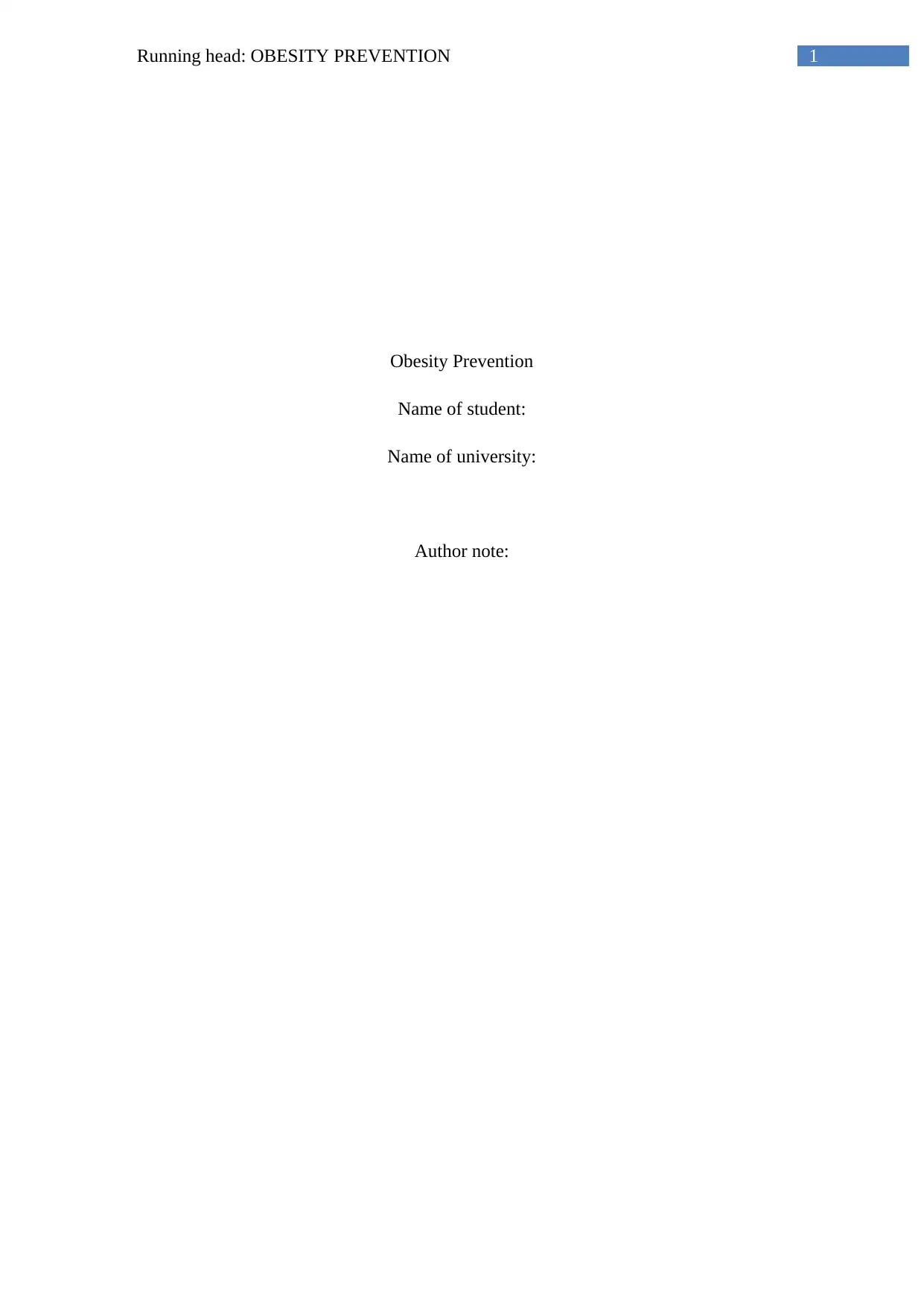
1Running head: OBESITY PREVENTION
Obesity Prevention
Name of student:
Name of university:
Author note:
Obesity Prevention
Name of student:
Name of university:
Author note:
Paraphrase This Document
Need a fresh take? Get an instant paraphrase of this document with our AI Paraphraser
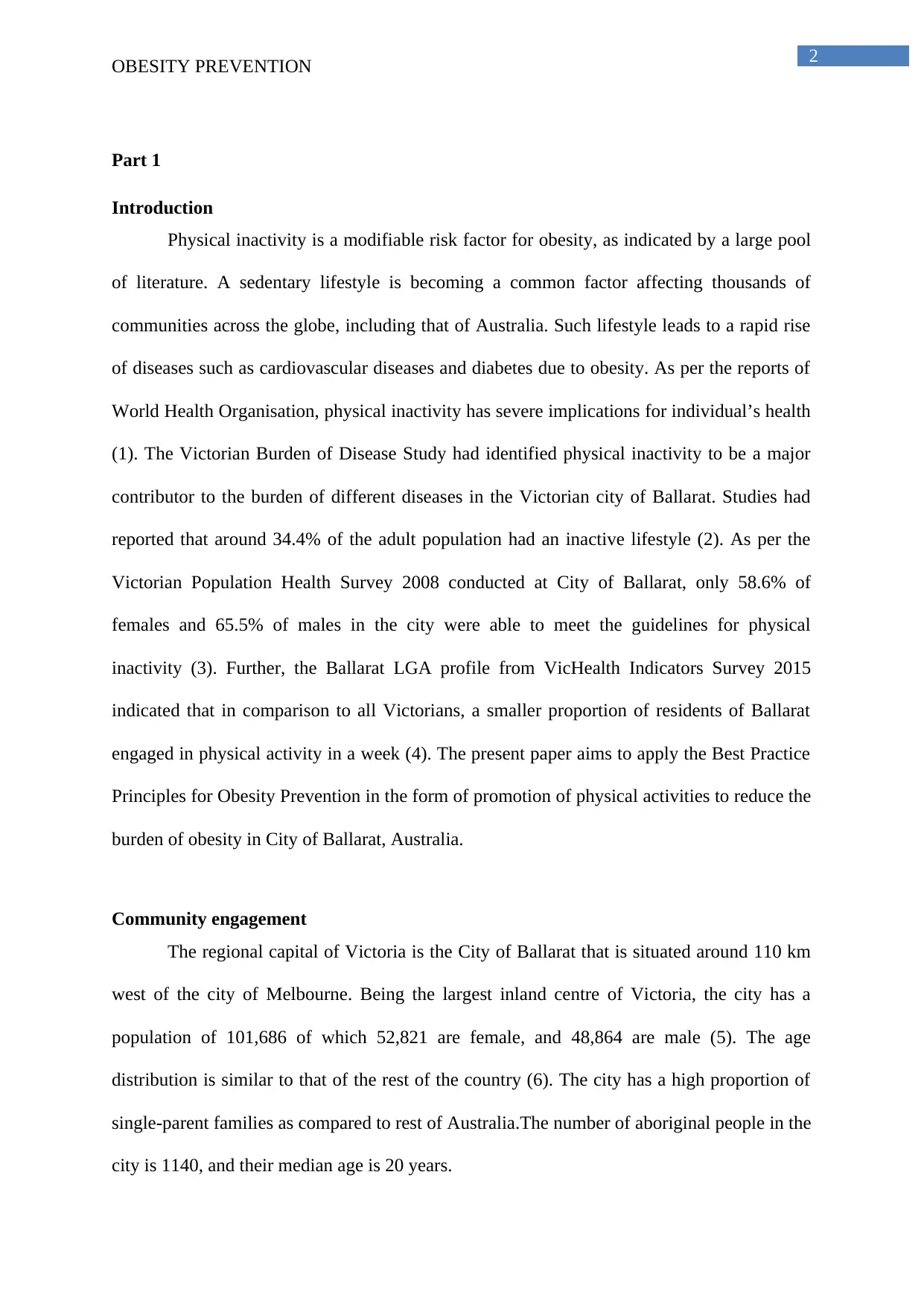
2
OBESITY PREVENTION
Part 1
Introduction
Physical inactivity is a modifiable risk factor for obesity, as indicated by a large pool
of literature. A sedentary lifestyle is becoming a common factor affecting thousands of
communities across the globe, including that of Australia. Such lifestyle leads to a rapid rise
of diseases such as cardiovascular diseases and diabetes due to obesity. As per the reports of
World Health Organisation, physical inactivity has severe implications for individual’s health
(1). The Victorian Burden of Disease Study had identified physical inactivity to be a major
contributor to the burden of different diseases in the Victorian city of Ballarat. Studies had
reported that around 34.4% of the adult population had an inactive lifestyle (2). As per the
Victorian Population Health Survey 2008 conducted at City of Ballarat, only 58.6% of
females and 65.5% of males in the city were able to meet the guidelines for physical
inactivity (3). Further, the Ballarat LGA profile from VicHealth Indicators Survey 2015
indicated that in comparison to all Victorians, a smaller proportion of residents of Ballarat
engaged in physical activity in a week (4). The present paper aims to apply the Best Practice
Principles for Obesity Prevention in the form of promotion of physical activities to reduce the
burden of obesity in City of Ballarat, Australia.
Community engagement
The regional capital of Victoria is the City of Ballarat that is situated around 110 km
west of the city of Melbourne. Being the largest inland centre of Victoria, the city has a
population of 101,686 of which 52,821 are female, and 48,864 are male (5). The age
distribution is similar to that of the rest of the country (6). The city has a high proportion of
single-parent families as compared to rest of Australia.The number of aboriginal people in the
city is 1140, and their median age is 20 years.
OBESITY PREVENTION
Part 1
Introduction
Physical inactivity is a modifiable risk factor for obesity, as indicated by a large pool
of literature. A sedentary lifestyle is becoming a common factor affecting thousands of
communities across the globe, including that of Australia. Such lifestyle leads to a rapid rise
of diseases such as cardiovascular diseases and diabetes due to obesity. As per the reports of
World Health Organisation, physical inactivity has severe implications for individual’s health
(1). The Victorian Burden of Disease Study had identified physical inactivity to be a major
contributor to the burden of different diseases in the Victorian city of Ballarat. Studies had
reported that around 34.4% of the adult population had an inactive lifestyle (2). As per the
Victorian Population Health Survey 2008 conducted at City of Ballarat, only 58.6% of
females and 65.5% of males in the city were able to meet the guidelines for physical
inactivity (3). Further, the Ballarat LGA profile from VicHealth Indicators Survey 2015
indicated that in comparison to all Victorians, a smaller proportion of residents of Ballarat
engaged in physical activity in a week (4). The present paper aims to apply the Best Practice
Principles for Obesity Prevention in the form of promotion of physical activities to reduce the
burden of obesity in City of Ballarat, Australia.
Community engagement
The regional capital of Victoria is the City of Ballarat that is situated around 110 km
west of the city of Melbourne. Being the largest inland centre of Victoria, the city has a
population of 101,686 of which 52,821 are female, and 48,864 are male (5). The age
distribution is similar to that of the rest of the country (6). The city has a high proportion of
single-parent families as compared to rest of Australia.The number of aboriginal people in the
city is 1140, and their median age is 20 years.
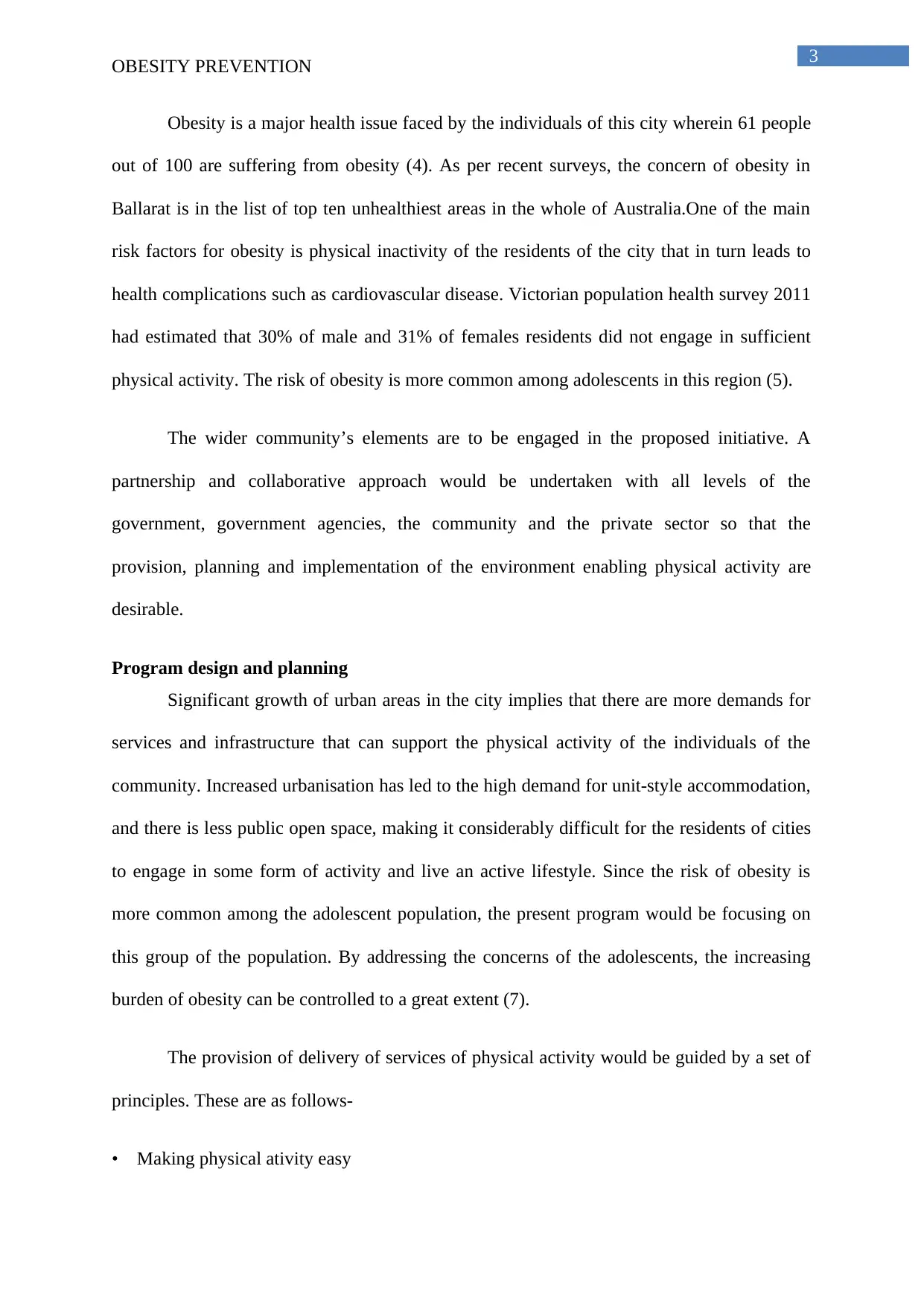
3
OBESITY PREVENTION
Obesity is a major health issue faced by the individuals of this city wherein 61 people
out of 100 are suffering from obesity (4). As per recent surveys, the concern of obesity in
Ballarat is in the list of top ten unhealthiest areas in the whole of Australia.One of the main
risk factors for obesity is physical inactivity of the residents of the city that in turn leads to
health complications such as cardiovascular disease. Victorian population health survey 2011
had estimated that 30% of male and 31% of females residents did not engage in sufficient
physical activity. The risk of obesity is more common among adolescents in this region (5).
The wider community’s elements are to be engaged in the proposed initiative. A
partnership and collaborative approach would be undertaken with all levels of the
government, government agencies, the community and the private sector so that the
provision, planning and implementation of the environment enabling physical activity are
desirable.
Program design and planning
Significant growth of urban areas in the city implies that there are more demands for
services and infrastructure that can support the physical activity of the individuals of the
community. Increased urbanisation has led to the high demand for unit-style accommodation,
and there is less public open space, making it considerably difficult for the residents of cities
to engage in some form of activity and live an active lifestyle. Since the risk of obesity is
more common among the adolescent population, the present program would be focusing on
this group of the population. By addressing the concerns of the adolescents, the increasing
burden of obesity can be controlled to a great extent (7).
The provision of delivery of services of physical activity would be guided by a set of
principles. These are as follows-
• Making physical ativity easy
OBESITY PREVENTION
Obesity is a major health issue faced by the individuals of this city wherein 61 people
out of 100 are suffering from obesity (4). As per recent surveys, the concern of obesity in
Ballarat is in the list of top ten unhealthiest areas in the whole of Australia.One of the main
risk factors for obesity is physical inactivity of the residents of the city that in turn leads to
health complications such as cardiovascular disease. Victorian population health survey 2011
had estimated that 30% of male and 31% of females residents did not engage in sufficient
physical activity. The risk of obesity is more common among adolescents in this region (5).
The wider community’s elements are to be engaged in the proposed initiative. A
partnership and collaborative approach would be undertaken with all levels of the
government, government agencies, the community and the private sector so that the
provision, planning and implementation of the environment enabling physical activity are
desirable.
Program design and planning
Significant growth of urban areas in the city implies that there are more demands for
services and infrastructure that can support the physical activity of the individuals of the
community. Increased urbanisation has led to the high demand for unit-style accommodation,
and there is less public open space, making it considerably difficult for the residents of cities
to engage in some form of activity and live an active lifestyle. Since the risk of obesity is
more common among the adolescent population, the present program would be focusing on
this group of the population. By addressing the concerns of the adolescents, the increasing
burden of obesity can be controlled to a great extent (7).
The provision of delivery of services of physical activity would be guided by a set of
principles. These are as follows-
• Making physical ativity easy
⊘ This is a preview!⊘
Do you want full access?
Subscribe today to unlock all pages.

Trusted by 1+ million students worldwide
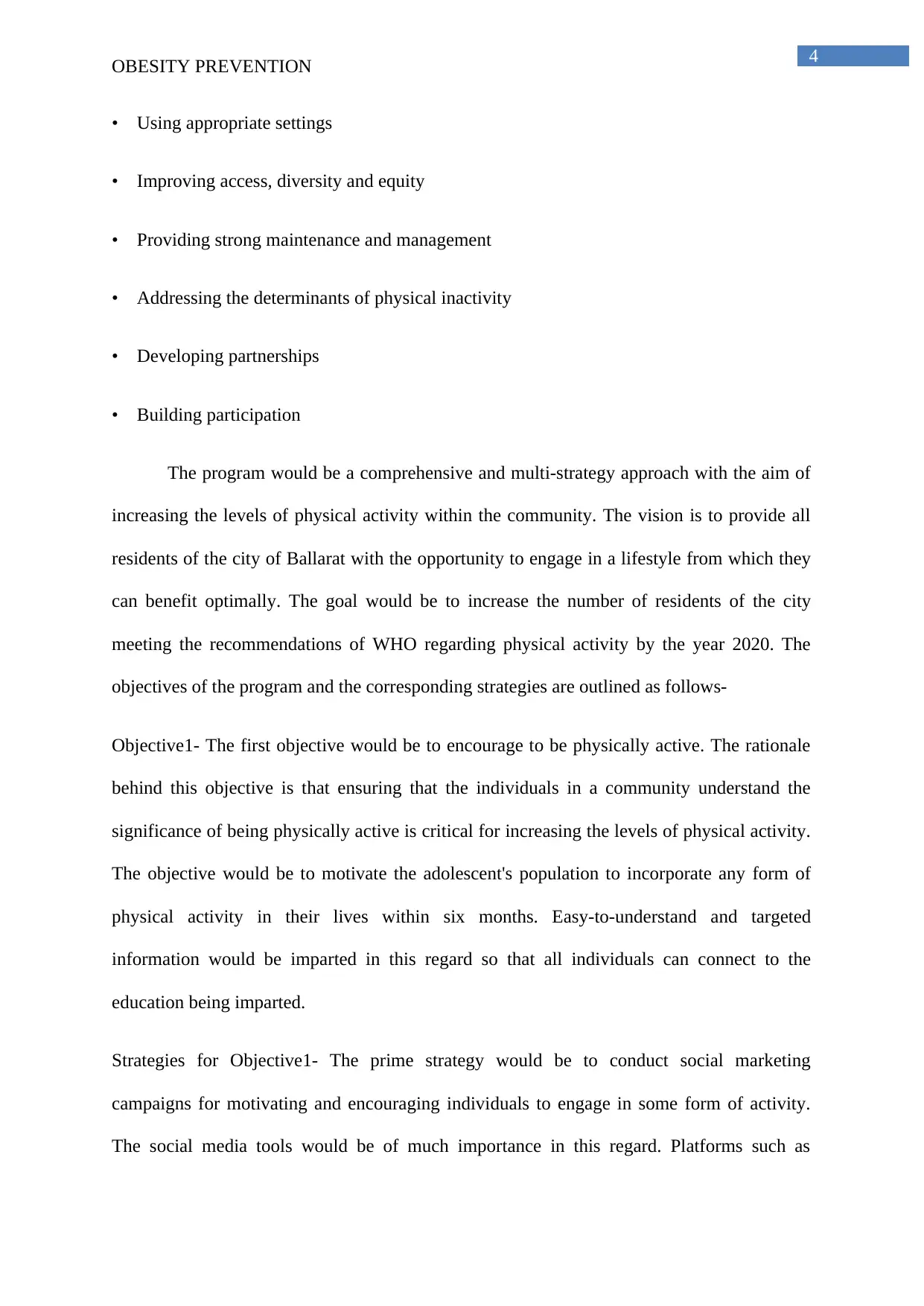
4
OBESITY PREVENTION
• Using appropriate settings
• Improving access, diversity and equity
• Providing strong maintenance and management
• Addressing the determinants of physical inactivity
• Developing partnerships
• Building participation
The program would be a comprehensive and multi-strategy approach with the aim of
increasing the levels of physical activity within the community. The vision is to provide all
residents of the city of Ballarat with the opportunity to engage in a lifestyle from which they
can benefit optimally. The goal would be to increase the number of residents of the city
meeting the recommendations of WHO regarding physical activity by the year 2020. The
objectives of the program and the corresponding strategies are outlined as follows-
Objective1- The first objective would be to encourage to be physically active. The rationale
behind this objective is that ensuring that the individuals in a community understand the
significance of being physically active is critical for increasing the levels of physical activity.
The objective would be to motivate the adolescent's population to incorporate any form of
physical activity in their lives within six months. Easy-to-understand and targeted
information would be imparted in this regard so that all individuals can connect to the
education being imparted.
Strategies for Objective1- The prime strategy would be to conduct social marketing
campaigns for motivating and encouraging individuals to engage in some form of activity.
The social media tools would be of much importance in this regard. Platforms such as
OBESITY PREVENTION
• Using appropriate settings
• Improving access, diversity and equity
• Providing strong maintenance and management
• Addressing the determinants of physical inactivity
• Developing partnerships
• Building participation
The program would be a comprehensive and multi-strategy approach with the aim of
increasing the levels of physical activity within the community. The vision is to provide all
residents of the city of Ballarat with the opportunity to engage in a lifestyle from which they
can benefit optimally. The goal would be to increase the number of residents of the city
meeting the recommendations of WHO regarding physical activity by the year 2020. The
objectives of the program and the corresponding strategies are outlined as follows-
Objective1- The first objective would be to encourage to be physically active. The rationale
behind this objective is that ensuring that the individuals in a community understand the
significance of being physically active is critical for increasing the levels of physical activity.
The objective would be to motivate the adolescent's population to incorporate any form of
physical activity in their lives within six months. Easy-to-understand and targeted
information would be imparted in this regard so that all individuals can connect to the
education being imparted.
Strategies for Objective1- The prime strategy would be to conduct social marketing
campaigns for motivating and encouraging individuals to engage in some form of activity.
The social media tools would be of much importance in this regard. Platforms such as
Paraphrase This Document
Need a fresh take? Get an instant paraphrase of this document with our AI Paraphraser
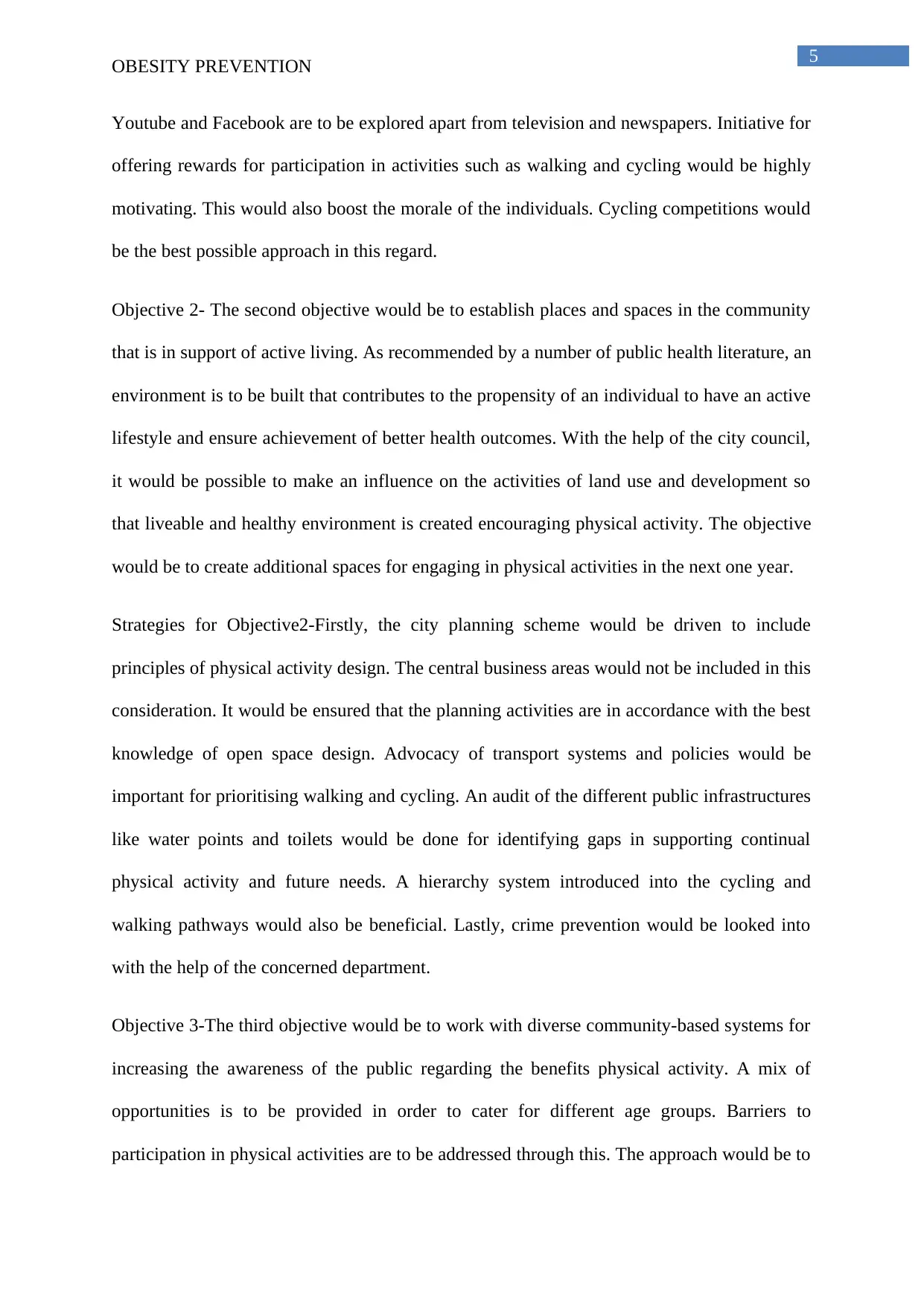
5
OBESITY PREVENTION
Youtube and Facebook are to be explored apart from television and newspapers. Initiative for
offering rewards for participation in activities such as walking and cycling would be highly
motivating. This would also boost the morale of the individuals. Cycling competitions would
be the best possible approach in this regard.
Objective 2- The second objective would be to establish places and spaces in the community
that is in support of active living. As recommended by a number of public health literature, an
environment is to be built that contributes to the propensity of an individual to have an active
lifestyle and ensure achievement of better health outcomes. With the help of the city council,
it would be possible to make an influence on the activities of land use and development so
that liveable and healthy environment is created encouraging physical activity. The objective
would be to create additional spaces for engaging in physical activities in the next one year.
Strategies for Objective2-Firstly, the city planning scheme would be driven to include
principles of physical activity design. The central business areas would not be included in this
consideration. It would be ensured that the planning activities are in accordance with the best
knowledge of open space design. Advocacy of transport systems and policies would be
important for prioritising walking and cycling. An audit of the different public infrastructures
like water points and toilets would be done for identifying gaps in supporting continual
physical activity and future needs. A hierarchy system introduced into the cycling and
walking pathways would also be beneficial. Lastly, crime prevention would be looked into
with the help of the concerned department.
Objective 3-The third objective would be to work with diverse community-based systems for
increasing the awareness of the public regarding the benefits physical activity. A mix of
opportunities is to be provided in order to cater for different age groups. Barriers to
participation in physical activities are to be addressed through this. The approach would be to
OBESITY PREVENTION
Youtube and Facebook are to be explored apart from television and newspapers. Initiative for
offering rewards for participation in activities such as walking and cycling would be highly
motivating. This would also boost the morale of the individuals. Cycling competitions would
be the best possible approach in this regard.
Objective 2- The second objective would be to establish places and spaces in the community
that is in support of active living. As recommended by a number of public health literature, an
environment is to be built that contributes to the propensity of an individual to have an active
lifestyle and ensure achievement of better health outcomes. With the help of the city council,
it would be possible to make an influence on the activities of land use and development so
that liveable and healthy environment is created encouraging physical activity. The objective
would be to create additional spaces for engaging in physical activities in the next one year.
Strategies for Objective2-Firstly, the city planning scheme would be driven to include
principles of physical activity design. The central business areas would not be included in this
consideration. It would be ensured that the planning activities are in accordance with the best
knowledge of open space design. Advocacy of transport systems and policies would be
important for prioritising walking and cycling. An audit of the different public infrastructures
like water points and toilets would be done for identifying gaps in supporting continual
physical activity and future needs. A hierarchy system introduced into the cycling and
walking pathways would also be beneficial. Lastly, crime prevention would be looked into
with the help of the concerned department.
Objective 3-The third objective would be to work with diverse community-based systems for
increasing the awareness of the public regarding the benefits physical activity. A mix of
opportunities is to be provided in order to cater for different age groups. Barriers to
participation in physical activities are to be addressed through this. The approach would be to
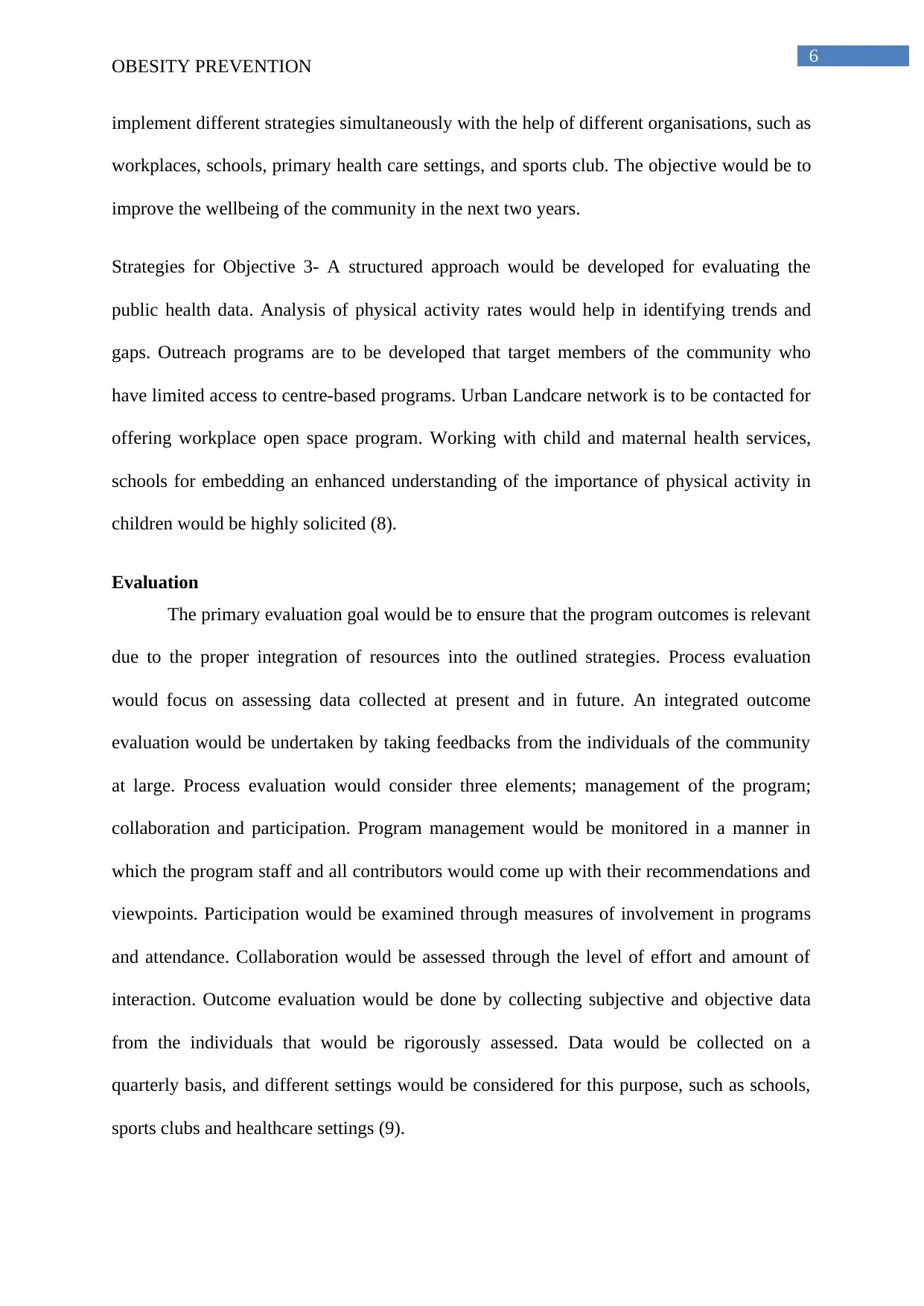
6
OBESITY PREVENTION
implement different strategies simultaneously with the help of different organisations, such as
workplaces, schools, primary health care settings, and sports club. The objective would be to
improve the wellbeing of the community in the next two years.
Strategies for Objective 3- A structured approach would be developed for evaluating the
public health data. Analysis of physical activity rates would help in identifying trends and
gaps. Outreach programs are to be developed that target members of the community who
have limited access to centre-based programs. Urban Landcare network is to be contacted for
offering workplace open space program. Working with child and maternal health services,
schools for embedding an enhanced understanding of the importance of physical activity in
children would be highly solicited (8).
Evaluation
The primary evaluation goal would be to ensure that the program outcomes is relevant
due to the proper integration of resources into the outlined strategies. Process evaluation
would focus on assessing data collected at present and in future. An integrated outcome
evaluation would be undertaken by taking feedbacks from the individuals of the community
at large. Process evaluation would consider three elements; management of the program;
collaboration and participation. Program management would be monitored in a manner in
which the program staff and all contributors would come up with their recommendations and
viewpoints. Participation would be examined through measures of involvement in programs
and attendance. Collaboration would be assessed through the level of effort and amount of
interaction. Outcome evaluation would be done by collecting subjective and objective data
from the individuals that would be rigorously assessed. Data would be collected on a
quarterly basis, and different settings would be considered for this purpose, such as schools,
sports clubs and healthcare settings (9).
OBESITY PREVENTION
implement different strategies simultaneously with the help of different organisations, such as
workplaces, schools, primary health care settings, and sports club. The objective would be to
improve the wellbeing of the community in the next two years.
Strategies for Objective 3- A structured approach would be developed for evaluating the
public health data. Analysis of physical activity rates would help in identifying trends and
gaps. Outreach programs are to be developed that target members of the community who
have limited access to centre-based programs. Urban Landcare network is to be contacted for
offering workplace open space program. Working with child and maternal health services,
schools for embedding an enhanced understanding of the importance of physical activity in
children would be highly solicited (8).
Evaluation
The primary evaluation goal would be to ensure that the program outcomes is relevant
due to the proper integration of resources into the outlined strategies. Process evaluation
would focus on assessing data collected at present and in future. An integrated outcome
evaluation would be undertaken by taking feedbacks from the individuals of the community
at large. Process evaluation would consider three elements; management of the program;
collaboration and participation. Program management would be monitored in a manner in
which the program staff and all contributors would come up with their recommendations and
viewpoints. Participation would be examined through measures of involvement in programs
and attendance. Collaboration would be assessed through the level of effort and amount of
interaction. Outcome evaluation would be done by collecting subjective and objective data
from the individuals that would be rigorously assessed. Data would be collected on a
quarterly basis, and different settings would be considered for this purpose, such as schools,
sports clubs and healthcare settings (9).
⊘ This is a preview!⊘
Do you want full access?
Subscribe today to unlock all pages.

Trusted by 1+ million students worldwide
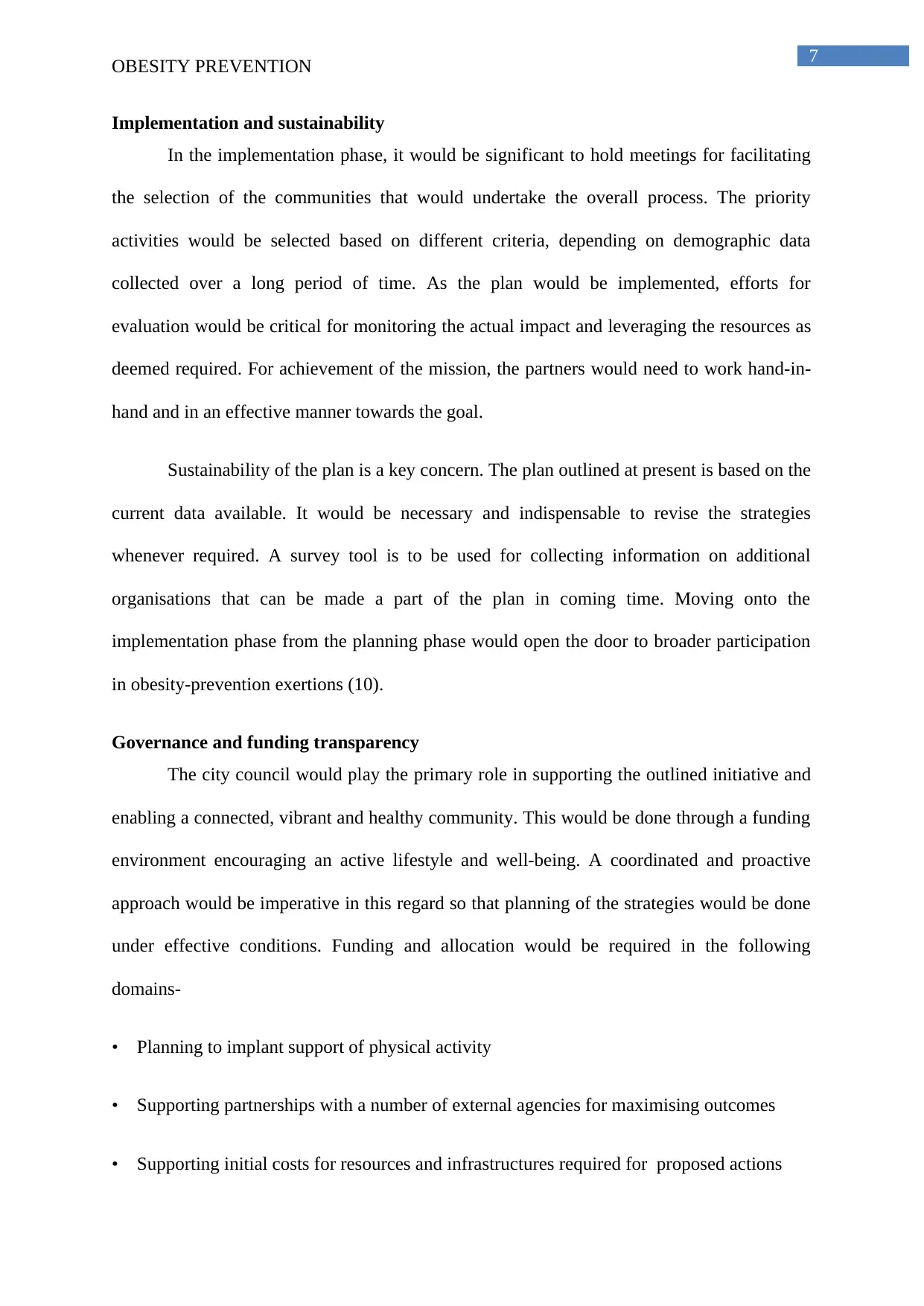
7
OBESITY PREVENTION
Implementation and sustainability
In the implementation phase, it would be significant to hold meetings for facilitating
the selection of the communities that would undertake the overall process. The priority
activities would be selected based on different criteria, depending on demographic data
collected over a long period of time. As the plan would be implemented, efforts for
evaluation would be critical for monitoring the actual impact and leveraging the resources as
deemed required. For achievement of the mission, the partners would need to work hand-in-
hand and in an effective manner towards the goal.
Sustainability of the plan is a key concern. The plan outlined at present is based on the
current data available. It would be necessary and indispensable to revise the strategies
whenever required. A survey tool is to be used for collecting information on additional
organisations that can be made a part of the plan in coming time. Moving onto the
implementation phase from the planning phase would open the door to broader participation
in obesity-prevention exertions (10).
Governance and funding transparency
The city council would play the primary role in supporting the outlined initiative and
enabling a connected, vibrant and healthy community. This would be done through a funding
environment encouraging an active lifestyle and well-being. A coordinated and proactive
approach would be imperative in this regard so that planning of the strategies would be done
under effective conditions. Funding and allocation would be required in the following
domains-
• Planning to implant support of physical activity
• Supporting partnerships with a number of external agencies for maximising outcomes
• Supporting initial costs for resources and infrastructures required for proposed actions
OBESITY PREVENTION
Implementation and sustainability
In the implementation phase, it would be significant to hold meetings for facilitating
the selection of the communities that would undertake the overall process. The priority
activities would be selected based on different criteria, depending on demographic data
collected over a long period of time. As the plan would be implemented, efforts for
evaluation would be critical for monitoring the actual impact and leveraging the resources as
deemed required. For achievement of the mission, the partners would need to work hand-in-
hand and in an effective manner towards the goal.
Sustainability of the plan is a key concern. The plan outlined at present is based on the
current data available. It would be necessary and indispensable to revise the strategies
whenever required. A survey tool is to be used for collecting information on additional
organisations that can be made a part of the plan in coming time. Moving onto the
implementation phase from the planning phase would open the door to broader participation
in obesity-prevention exertions (10).
Governance and funding transparency
The city council would play the primary role in supporting the outlined initiative and
enabling a connected, vibrant and healthy community. This would be done through a funding
environment encouraging an active lifestyle and well-being. A coordinated and proactive
approach would be imperative in this regard so that planning of the strategies would be done
under effective conditions. Funding and allocation would be required in the following
domains-
• Planning to implant support of physical activity
• Supporting partnerships with a number of external agencies for maximising outcomes
• Supporting initial costs for resources and infrastructures required for proposed actions
Paraphrase This Document
Need a fresh take? Get an instant paraphrase of this document with our AI Paraphraser
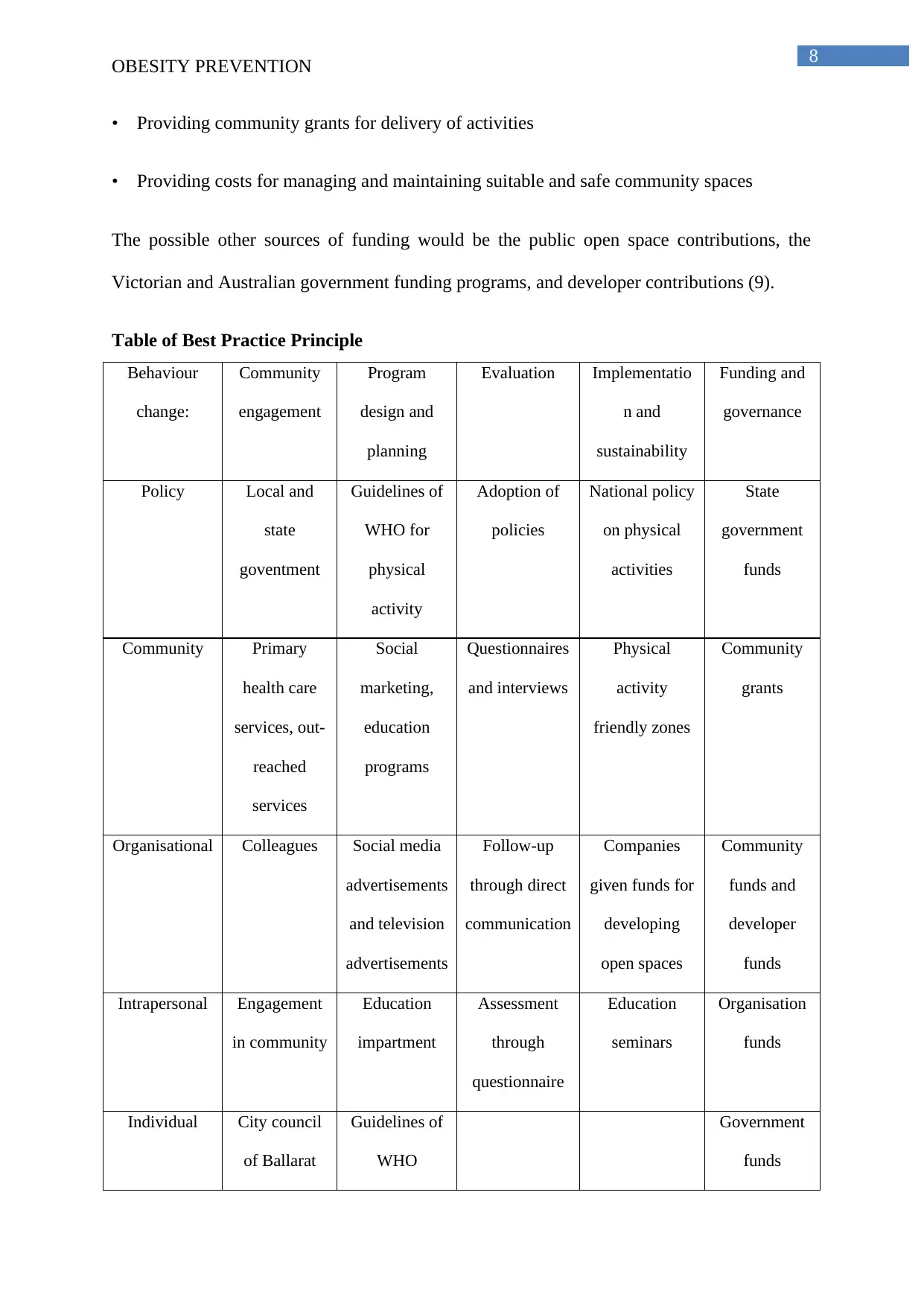
8
OBESITY PREVENTION
• Providing community grants for delivery of activities
• Providing costs for managing and maintaining suitable and safe community spaces
The possible other sources of funding would be the public open space contributions, the
Victorian and Australian government funding programs, and developer contributions (9).
Table of Best Practice Principle
Behaviour
change:
Community
engagement
Program
design and
planning
Evaluation Implementatio
n and
sustainability
Funding and
governance
Policy Local and
state
goventment
Guidelines of
WHO for
physical
activity
Adoption of
policies
National policy
on physical
activities
State
government
funds
Community Primary
health care
services, out-
reached
services
Social
marketing,
education
programs
Questionnaires
and interviews
Physical
activity
friendly zones
Community
grants
Organisational Colleagues Social media
advertisements
and television
advertisements
Follow-up
through direct
communication
Companies
given funds for
developing
open spaces
Community
funds and
developer
funds
Intrapersonal Engagement
in community
Education
impartment
Assessment
through
questionnaire
Education
seminars
Organisation
funds
Individual City council
of Ballarat
Guidelines of
WHO
Government
funds
OBESITY PREVENTION
• Providing community grants for delivery of activities
• Providing costs for managing and maintaining suitable and safe community spaces
The possible other sources of funding would be the public open space contributions, the
Victorian and Australian government funding programs, and developer contributions (9).
Table of Best Practice Principle
Behaviour
change:
Community
engagement
Program
design and
planning
Evaluation Implementatio
n and
sustainability
Funding and
governance
Policy Local and
state
goventment
Guidelines of
WHO for
physical
activity
Adoption of
policies
National policy
on physical
activities
State
government
funds
Community Primary
health care
services, out-
reached
services
Social
marketing,
education
programs
Questionnaires
and interviews
Physical
activity
friendly zones
Community
grants
Organisational Colleagues Social media
advertisements
and television
advertisements
Follow-up
through direct
communication
Companies
given funds for
developing
open spaces
Community
funds and
developer
funds
Intrapersonal Engagement
in community
Education
impartment
Assessment
through
questionnaire
Education
seminars
Organisation
funds
Individual City council
of Ballarat
Guidelines of
WHO
Government
funds
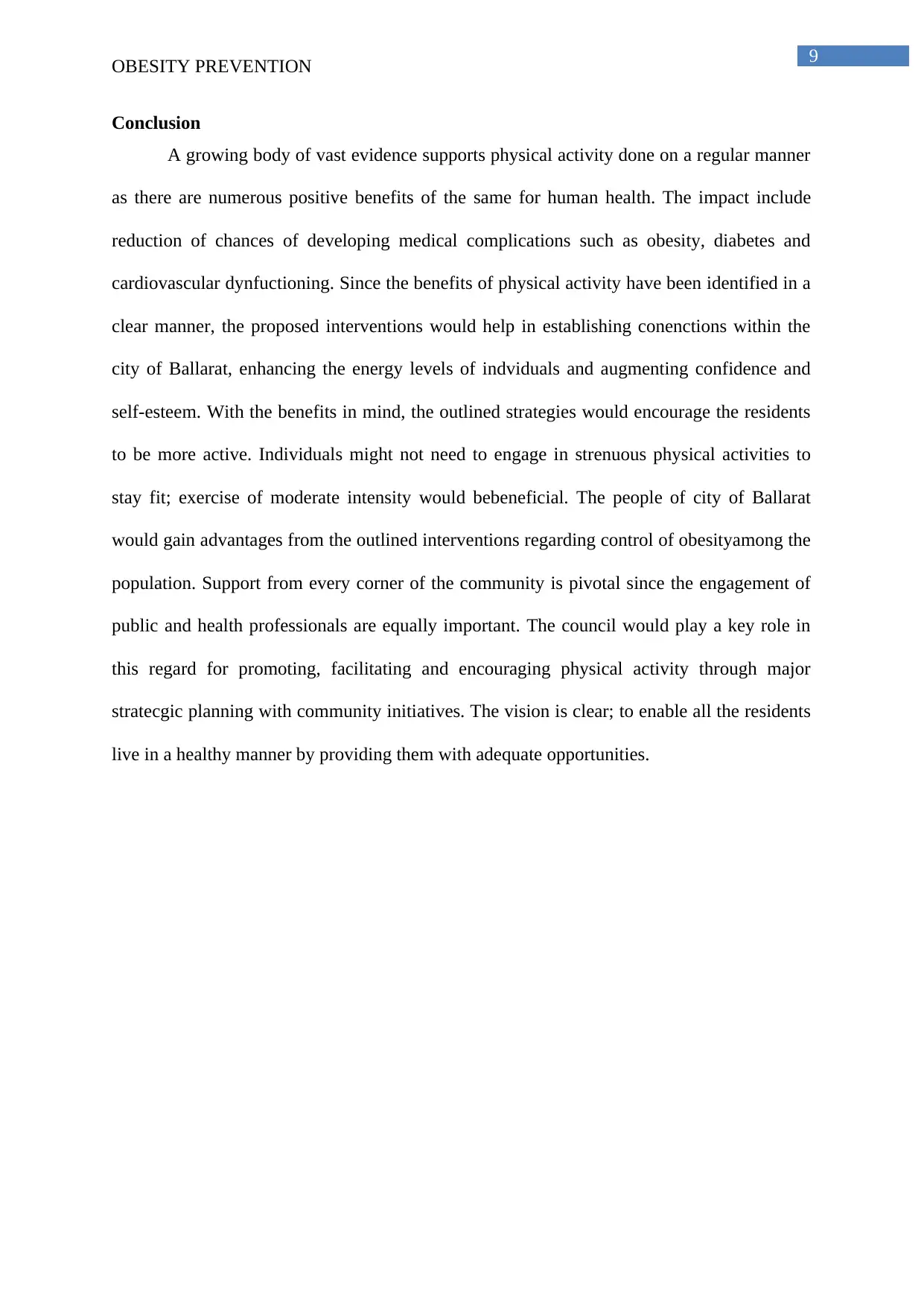
9
OBESITY PREVENTION
Conclusion
A growing body of vast evidence supports physical activity done on a regular manner
as there are numerous positive benefits of the same for human health. The impact include
reduction of chances of developing medical complications such as obesity, diabetes and
cardiovascular dynfuctioning. Since the benefits of physical activity have been identified in a
clear manner, the proposed interventions would help in establishing conenctions within the
city of Ballarat, enhancing the energy levels of indviduals and augmenting confidence and
self-esteem. With the benefits in mind, the outlined strategies would encourage the residents
to be more active. Individuals might not need to engage in strenuous physical activities to
stay fit; exercise of moderate intensity would bebeneficial. The people of city of Ballarat
would gain advantages from the outlined interventions regarding control of obesityamong the
population. Support from every corner of the community is pivotal since the engagement of
public and health professionals are equally important. The council would play a key role in
this regard for promoting, facilitating and encouraging physical activity through major
stratecgic planning with community initiatives. The vision is clear; to enable all the residents
live in a healthy manner by providing them with adequate opportunities.
OBESITY PREVENTION
Conclusion
A growing body of vast evidence supports physical activity done on a regular manner
as there are numerous positive benefits of the same for human health. The impact include
reduction of chances of developing medical complications such as obesity, diabetes and
cardiovascular dynfuctioning. Since the benefits of physical activity have been identified in a
clear manner, the proposed interventions would help in establishing conenctions within the
city of Ballarat, enhancing the energy levels of indviduals and augmenting confidence and
self-esteem. With the benefits in mind, the outlined strategies would encourage the residents
to be more active. Individuals might not need to engage in strenuous physical activities to
stay fit; exercise of moderate intensity would bebeneficial. The people of city of Ballarat
would gain advantages from the outlined interventions regarding control of obesityamong the
population. Support from every corner of the community is pivotal since the engagement of
public and health professionals are equally important. The council would play a key role in
this regard for promoting, facilitating and encouraging physical activity through major
stratecgic planning with community initiatives. The vision is clear; to enable all the residents
live in a healthy manner by providing them with adequate opportunities.
⊘ This is a preview!⊘
Do you want full access?
Subscribe today to unlock all pages.

Trusted by 1+ million students worldwide
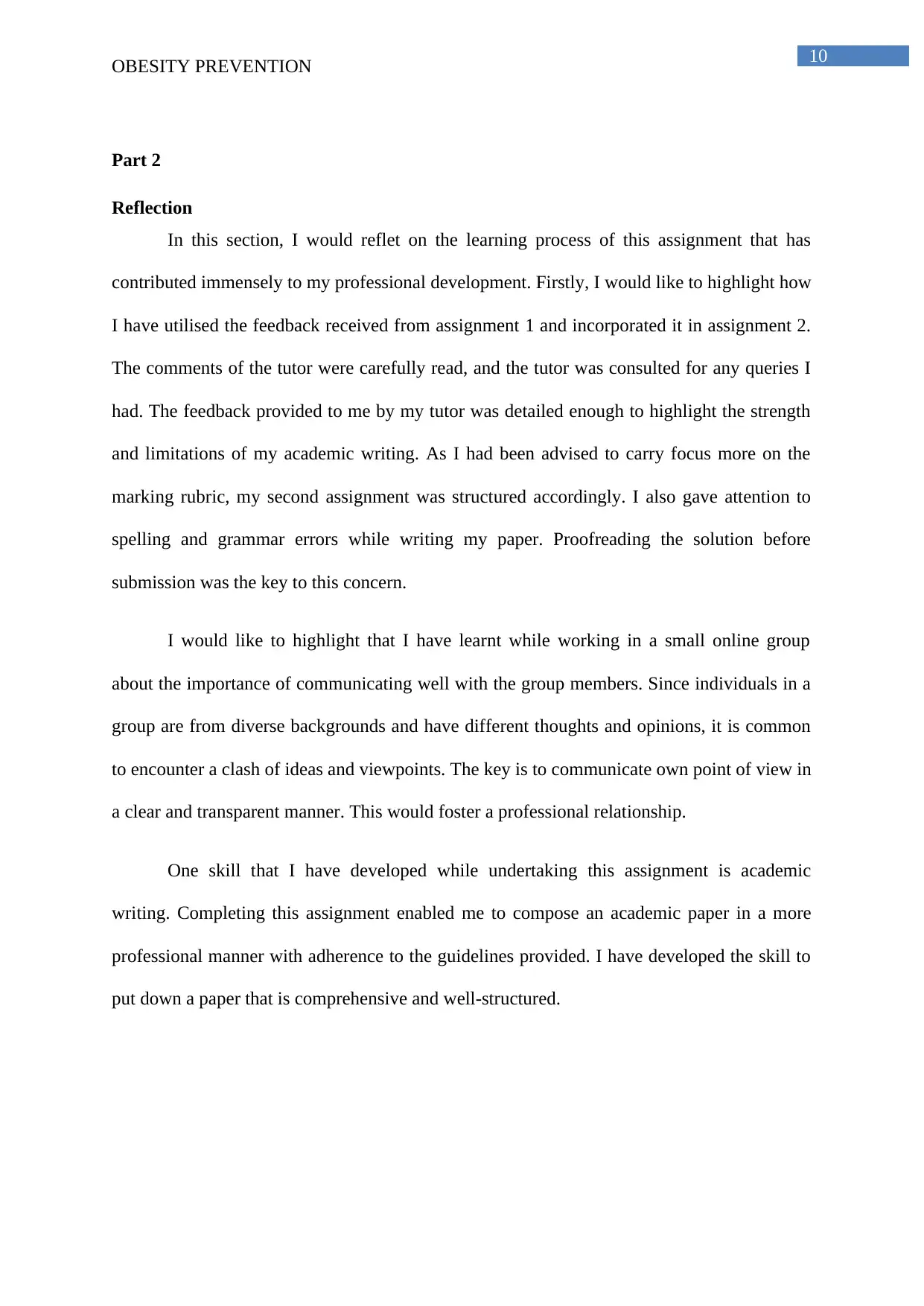
10
OBESITY PREVENTION
Part 2
Reflection
In this section, I would reflet on the learning process of this assignment that has
contributed immensely to my professional development. Firstly, I would like to highlight how
I have utilised the feedback received from assignment 1 and incorporated it in assignment 2.
The comments of the tutor were carefully read, and the tutor was consulted for any queries I
had. The feedback provided to me by my tutor was detailed enough to highlight the strength
and limitations of my academic writing. As I had been advised to carry focus more on the
marking rubric, my second assignment was structured accordingly. I also gave attention to
spelling and grammar errors while writing my paper. Proofreading the solution before
submission was the key to this concern.
I would like to highlight that I have learnt while working in a small online group
about the importance of communicating well with the group members. Since individuals in a
group are from diverse backgrounds and have different thoughts and opinions, it is common
to encounter a clash of ideas and viewpoints. The key is to communicate own point of view in
a clear and transparent manner. This would foster a professional relationship.
One skill that I have developed while undertaking this assignment is academic
writing. Completing this assignment enabled me to compose an academic paper in a more
professional manner with adherence to the guidelines provided. I have developed the skill to
put down a paper that is comprehensive and well-structured.
OBESITY PREVENTION
Part 2
Reflection
In this section, I would reflet on the learning process of this assignment that has
contributed immensely to my professional development. Firstly, I would like to highlight how
I have utilised the feedback received from assignment 1 and incorporated it in assignment 2.
The comments of the tutor were carefully read, and the tutor was consulted for any queries I
had. The feedback provided to me by my tutor was detailed enough to highlight the strength
and limitations of my academic writing. As I had been advised to carry focus more on the
marking rubric, my second assignment was structured accordingly. I also gave attention to
spelling and grammar errors while writing my paper. Proofreading the solution before
submission was the key to this concern.
I would like to highlight that I have learnt while working in a small online group
about the importance of communicating well with the group members. Since individuals in a
group are from diverse backgrounds and have different thoughts and opinions, it is common
to encounter a clash of ideas and viewpoints. The key is to communicate own point of view in
a clear and transparent manner. This would foster a professional relationship.
One skill that I have developed while undertaking this assignment is academic
writing. Completing this assignment enabled me to compose an academic paper in a more
professional manner with adherence to the guidelines provided. I have developed the skill to
put down a paper that is comprehensive and well-structured.
Paraphrase This Document
Need a fresh take? Get an instant paraphrase of this document with our AI Paraphraser
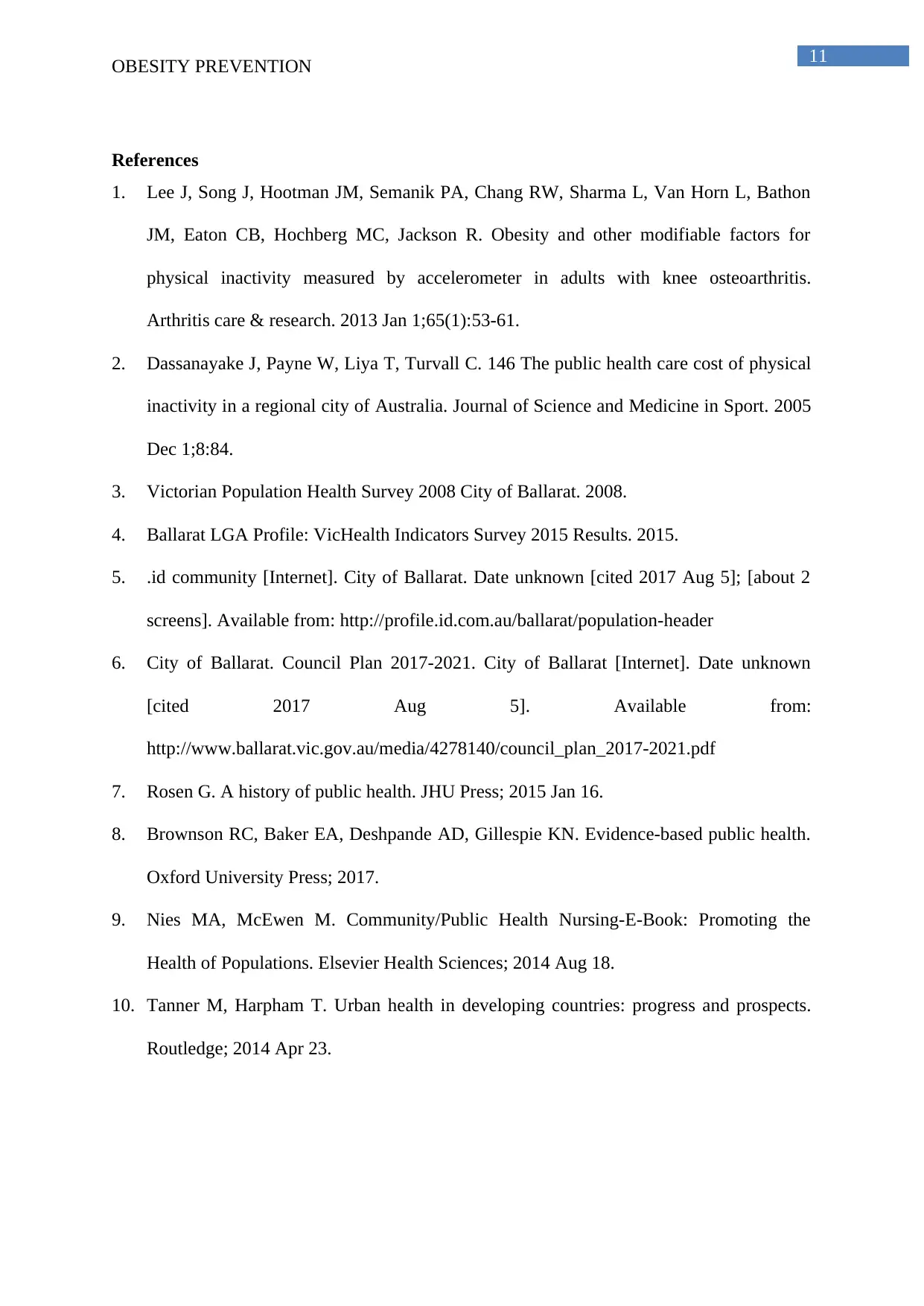
11
OBESITY PREVENTION
References
1. Lee J, Song J, Hootman JM, Semanik PA, Chang RW, Sharma L, Van Horn L, Bathon
JM, Eaton CB, Hochberg MC, Jackson R. Obesity and other modifiable factors for
physical inactivity measured by accelerometer in adults with knee osteoarthritis.
Arthritis care & research. 2013 Jan 1;65(1):53-61.
2. Dassanayake J, Payne W, Liya T, Turvall C. 146 The public health care cost of physical
inactivity in a regional city of Australia. Journal of Science and Medicine in Sport. 2005
Dec 1;8:84.
3. Victorian Population Health Survey 2008 City of Ballarat. 2008.
4. Ballarat LGA Profile: VicHealth Indicators Survey 2015 Results. 2015.
5. .id community [Internet]. City of Ballarat. Date unknown [cited 2017 Aug 5]; [about 2
screens]. Available from: http://profile.id.com.au/ballarat/population-header
6. City of Ballarat. Council Plan 2017-2021. City of Ballarat [Internet]. Date unknown
[cited 2017 Aug 5]. Available from:
http://www.ballarat.vic.gov.au/media/4278140/council_plan_2017-2021.pdf
7. Rosen G. A history of public health. JHU Press; 2015 Jan 16.
8. Brownson RC, Baker EA, Deshpande AD, Gillespie KN. Evidence-based public health.
Oxford University Press; 2017.
9. Nies MA, McEwen M. Community/Public Health Nursing-E-Book: Promoting the
Health of Populations. Elsevier Health Sciences; 2014 Aug 18.
10. Tanner M, Harpham T. Urban health in developing countries: progress and prospects.
Routledge; 2014 Apr 23.
OBESITY PREVENTION
References
1. Lee J, Song J, Hootman JM, Semanik PA, Chang RW, Sharma L, Van Horn L, Bathon
JM, Eaton CB, Hochberg MC, Jackson R. Obesity and other modifiable factors for
physical inactivity measured by accelerometer in adults with knee osteoarthritis.
Arthritis care & research. 2013 Jan 1;65(1):53-61.
2. Dassanayake J, Payne W, Liya T, Turvall C. 146 The public health care cost of physical
inactivity in a regional city of Australia. Journal of Science and Medicine in Sport. 2005
Dec 1;8:84.
3. Victorian Population Health Survey 2008 City of Ballarat. 2008.
4. Ballarat LGA Profile: VicHealth Indicators Survey 2015 Results. 2015.
5. .id community [Internet]. City of Ballarat. Date unknown [cited 2017 Aug 5]; [about 2
screens]. Available from: http://profile.id.com.au/ballarat/population-header
6. City of Ballarat. Council Plan 2017-2021. City of Ballarat [Internet]. Date unknown
[cited 2017 Aug 5]. Available from:
http://www.ballarat.vic.gov.au/media/4278140/council_plan_2017-2021.pdf
7. Rosen G. A history of public health. JHU Press; 2015 Jan 16.
8. Brownson RC, Baker EA, Deshpande AD, Gillespie KN. Evidence-based public health.
Oxford University Press; 2017.
9. Nies MA, McEwen M. Community/Public Health Nursing-E-Book: Promoting the
Health of Populations. Elsevier Health Sciences; 2014 Aug 18.
10. Tanner M, Harpham T. Urban health in developing countries: progress and prospects.
Routledge; 2014 Apr 23.
1 out of 11
Related Documents
Your All-in-One AI-Powered Toolkit for Academic Success.
+13062052269
info@desklib.com
Available 24*7 on WhatsApp / Email
![[object Object]](/_next/static/media/star-bottom.7253800d.svg)
Unlock your academic potential
Copyright © 2020–2025 A2Z Services. All Rights Reserved. Developed and managed by ZUCOL.





